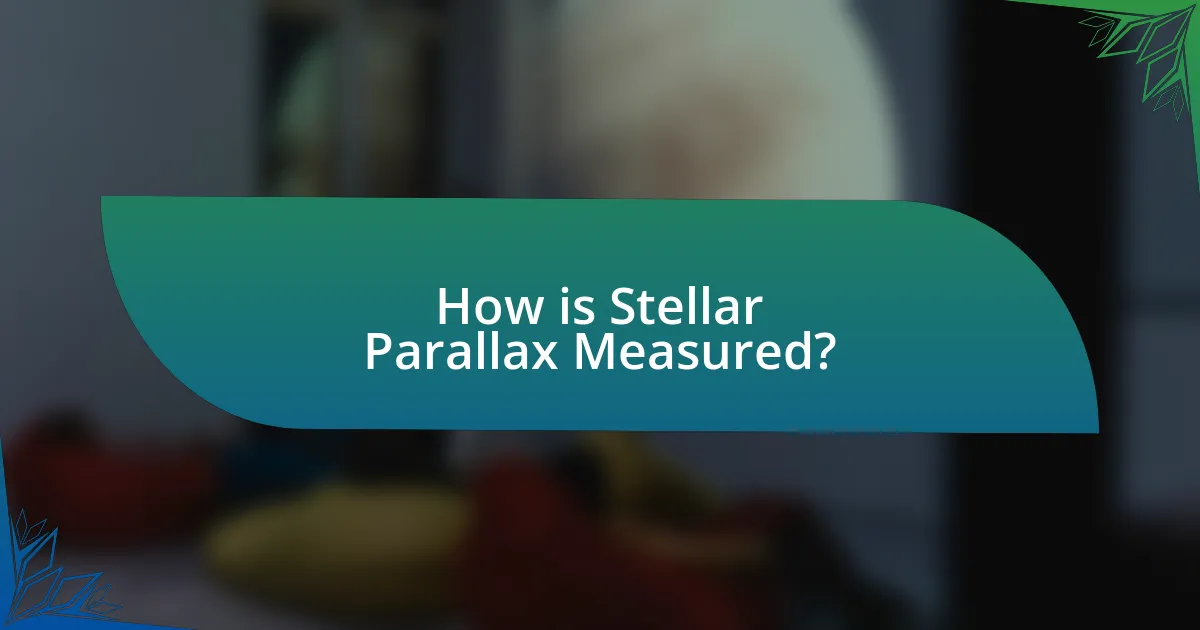Stellar parallax is the apparent shift in a star’s position against a distant background as observed from different points in Earth’s orbit, a phenomenon crucial for measuring distances to nearby stars. This article explores the definition, significance, and measurement techniques of stellar parallax, detailing how it aids in establishing the cosmic distance scale and enhances our understanding of stellar properties. It also discusses the challenges faced in measuring parallax, the advancements in observational technology, and the implications for future astronomical research. By providing a comprehensive overview of stellar parallax, the article highlights its foundational role in astronomy and its impact on our understanding of the universe.

What is Stellar Parallax?
Stellar parallax is the apparent shift in the position of a star against a distant background when observed from different positions in Earth’s orbit. This phenomenon occurs due to the change in the observer’s viewpoint as Earth moves around the Sun, allowing astronomers to measure the distance to nearby stars. The measurement of stellar parallax is fundamental in astronomy, as it provides a method for determining stellar distances, with a parallax angle of one arcsecond corresponding to a distance of one parsec, approximately 3.26 light-years.
How is Stellar Parallax defined in astronomy?
Stellar parallax is defined in astronomy as the apparent shift in the position of a nearby star against the background of distant stars as observed from different positions of the Earth in its orbit around the Sun. This phenomenon occurs due to the change in the observer’s viewpoint, allowing astronomers to measure the distance to stars using trigonometric methods. The measurement of stellar parallax is typically expressed in arcseconds, with a parallax of one arcsecond corresponding to a distance of one parsec, approximately 3.26 light-years. This relationship is foundational in establishing the scale of the universe and has been crucial in determining the distances to stars since the 19th century.
What measurements are involved in determining stellar parallax?
The measurements involved in determining stellar parallax include the angle of parallax, the distance to the observer, and the baseline distance between two observation points on Earth. The angle of parallax is measured by observing the apparent shift in a star’s position against more distant background stars as Earth orbits the Sun. This shift is typically measured in arcseconds. The baseline distance is usually the diameter of Earth’s orbit, approximately 2 astronomical units (AU). By applying the formula for parallax, which relates these measurements, astronomers can calculate the distance to the star in parsecs, where one parsec corresponds to a parallax angle of one arcsecond.
How does the distance of a star affect its parallax angle?
The distance of a star inversely affects its parallax angle; as the distance increases, the parallax angle decreases. Parallax is the apparent shift in a star’s position against a distant background when observed from different points in Earth’s orbit. For example, a star located 1 parsec away exhibits a parallax angle of 1 arcsecond, while a star at 10 parsecs shows a parallax angle of 0.1 arcseconds. This relationship is mathematically expressed by the formula: parallax angle (in arcseconds) = 1 / distance (in parsecs). Thus, the farther a star is, the smaller its parallax angle becomes, confirming the inverse relationship between distance and parallax.
Why is Stellar Parallax significant in the study of astronomy?
Stellar parallax is significant in the study of astronomy because it provides a method for measuring the distances to nearby stars. This technique relies on observing the apparent shift in a star’s position against more distant background stars as Earth orbits the Sun. The first successful measurement of stellar parallax was achieved by Friedrich Bessel in 1838, who calculated the distance to the star 61 Cygni, demonstrating that stars are not fixed points but rather have measurable distances from Earth. This foundational concept allows astronomers to establish the scale of the universe, leading to further discoveries about stellar properties and the structure of our galaxy.
What role does stellar parallax play in measuring astronomical distances?
Stellar parallax is crucial for measuring astronomical distances as it provides a method to determine the distance to nearby stars based on their apparent movement against more distant background stars. This phenomenon occurs when the position of a star appears to shift due to the Earth’s orbit around the Sun, allowing astronomers to calculate distances using trigonometry. Specifically, the angle of parallax is measured in arcseconds, and the distance in parsecs can be derived using the formula: distance (in parsecs) = 1 / parallax angle (in arcseconds). This method has been validated through observations, such as those conducted by the Hipparcos satellite, which accurately measured the parallax of over 118,000 stars, confirming the effectiveness of stellar parallax in distance measurement.
How has stellar parallax contributed to our understanding of the universe?
Stellar parallax has significantly enhanced our understanding of the universe by providing a method to measure the distances to nearby stars. This technique, first successfully employed by Friedrich Bessel in 1838, involves observing the apparent shift in a star’s position against distant background stars as Earth orbits the Sun. By measuring this angular shift, astronomers can calculate the distance to the star using trigonometry, establishing a baseline for the cosmic distance scale. The successful application of stellar parallax has allowed for the determination of distances to stars within a few hundred light-years, which is crucial for understanding the structure and scale of the Milky Way galaxy and the universe at large.

How is Stellar Parallax Measured?
Stellar parallax is measured by observing the apparent shift in a star’s position against a background of more distant stars as Earth orbits the Sun. This measurement relies on the baseline distance of Earth’s orbit, typically taken as 1 astronomical unit (AU), and involves taking two observations of the star at different points in Earth’s orbit, usually six months apart. The angle of parallax, which is half the angular shift observed, is then calculated, allowing astronomers to determine the distance to the star using the formula: distance (in parsecs) equals 1 divided by the parallax angle (in arcseconds). This method is validated by the fact that the nearest stars, such as Proxima Centauri, have measurable parallax angles, confirming the effectiveness of this technique in determining stellar distances.
What methods are used to measure stellar parallax?
Stellar parallax is measured primarily using two methods: ground-based observations and space-based observations. Ground-based observations utilize telescopes to capture images of stars at different times of the year, allowing astronomers to calculate the apparent shift in position against more distant background stars. This method relies on precise measurements of angles and distances, typically using the baseline of Earth’s orbit around the Sun, which is about 2 astronomical units. Space-based observations, such as those conducted by the Gaia spacecraft, provide more accurate measurements by eliminating atmospheric distortion and allowing for continuous observation of stars over time. Gaia has measured parallax for over a billion stars, achieving precision down to microarcseconds, which significantly enhances the accuracy of distance calculations in the universe.
How do ground-based telescopes contribute to parallax measurements?
Ground-based telescopes contribute to parallax measurements by providing precise observations of stellar positions from different points in Earth’s orbit. These telescopes capture images of stars at different times of the year, allowing astronomers to measure the apparent shift in a star’s position against more distant background stars. This shift, known as parallax, is used to calculate the distance to the star using the formula d = 1/p, where d is the distance in parsecs and p is the parallax angle in arcseconds. The accuracy of these measurements is enhanced by the high-resolution capabilities of modern ground-based telescopes, which can detect minute changes in position, thus improving the reliability of distance calculations in astronomy.
What advancements have space telescopes brought to measuring parallax?
Space telescopes have significantly enhanced the measurement of parallax by providing clearer, more stable observations of celestial objects. The Hubble Space Telescope, for instance, has enabled astronomers to measure the parallax of stars up to 10,000 light-years away with unprecedented accuracy, reducing the uncertainty in distance calculations. This improvement is largely due to the telescope’s position above Earth’s atmosphere, which eliminates atmospheric distortion and allows for precise angular measurements. Additionally, missions like the Gaia spacecraft have revolutionized parallax measurements by mapping over a billion stars in our galaxy, achieving a precision of microarcseconds, which is essential for determining distances to stars with high accuracy. These advancements have fundamentally improved our understanding of the scale of the universe and the distribution of stars within it.
What challenges are faced in measuring Stellar Parallax?
Measuring stellar parallax faces several challenges, primarily due to the vast distances involved and the limitations of current observational technology. The first challenge is the extremely small angles involved; for example, the parallax angle of Proxima Centauri is only about 0.768 arcseconds, making it difficult to measure accurately. Additionally, atmospheric distortion can affect observations from Earth, leading to inaccuracies in the measured angles. Furthermore, the motion of the Earth around the Sun introduces complications, as parallax measurements must account for this orbital motion to ensure precision. Finally, the faintness of distant stars can limit the effectiveness of telescopes, making it harder to obtain reliable data. These factors collectively hinder the accurate measurement of stellar parallax, which is crucial for determining distances to stars and understanding the structure of our galaxy.
How do atmospheric conditions affect parallax measurements?
Atmospheric conditions significantly affect parallax measurements by introducing distortions that can alter the perceived position of celestial objects. Variations in temperature, humidity, and air pressure can cause refraction of light, leading to inaccuracies in the angles measured for parallax. For instance, turbulent air can create a shimmering effect, known as atmospheric turbulence, which can mislead astronomers about the true position of stars. Studies have shown that these atmospheric effects can introduce errors in parallax measurements by several milliarcseconds, impacting the precision of distance calculations in astronomy.
What are the limitations of current parallax measurement techniques?
Current parallax measurement techniques are limited by factors such as distance accuracy, atmospheric interference, and instrument precision. Specifically, parallax measurements become less reliable for stars located beyond approximately 10 parsecs due to the diminishing angle of parallax, which leads to increased uncertainty in distance calculations. Additionally, atmospheric turbulence can distort the light from stars, affecting the precision of measurements taken from Earth-based observatories. Furthermore, the instruments used, such as telescopes, have inherent limitations in resolution and sensitivity, which can introduce errors in the parallax angle determination. These limitations highlight the challenges faced in accurately measuring stellar distances, which are crucial for understanding the scale of the universe.

What are the Applications of Stellar Parallax in Astronomy?
Stellar parallax is primarily used in astronomy to measure the distances to nearby stars. This technique involves observing the apparent shift in a star’s position against distant background stars as Earth orbits the Sun. By measuring this angular shift, astronomers can apply trigonometry to calculate the star’s distance in parsecs, with one parsec equivalent to about 3.26 light-years. The accuracy of stellar parallax measurements has been validated through missions like the Hipparcos satellite, which provided precise distance measurements for over 100,000 stars, significantly enhancing our understanding of the Milky Way and the scale of the universe.
How does Stellar Parallax aid in the calibration of distance scales?
Stellar parallax aids in the calibration of distance scales by providing a direct measurement of the distance to nearby stars through the apparent shift in their position as observed from different points in Earth’s orbit. This method relies on the principle that as Earth moves, nearby stars appear to shift against the more distant background stars, allowing astronomers to calculate their distances using trigonometry. Specifically, the parallax angle, measured in arcseconds, is inversely proportional to the distance in parsecs, enabling precise distance estimations. For example, the star Proxima Centauri has a parallax of about 0.768 arcseconds, indicating it is approximately 1.3 parsecs away. This foundational technique establishes a reliable distance scale that is essential for further astronomical measurements and understanding the structure of the universe.
What is the relationship between stellar parallax and the cosmic distance ladder?
Stellar parallax is the foundational method for measuring distances to nearby stars, and it serves as the first rung on the cosmic distance ladder. The cosmic distance ladder is a series of methods used by astronomers to determine distances in the universe, where each method builds upon the previous one. Stellar parallax provides direct distance measurements for stars within a few hundred light-years, which are then used to calibrate other distance measurement techniques, such as standard candles and redshift methods. This calibration is crucial because it allows astronomers to extend distance measurements to more distant celestial objects, thereby creating a comprehensive framework for understanding the scale of the universe.
How does parallax improve our understanding of star properties?
Parallax improves our understanding of star properties by providing a method to measure the distances to stars accurately. This distance measurement is crucial because it allows astronomers to calculate other properties of stars, such as their luminosity and size, using the inverse square law of light. For instance, the parallax angle, measured in arcseconds, directly relates to the distance in parsecs, enabling precise distance calculations. The European Space Agency’s Gaia mission has utilized parallax to measure distances to over a billion stars, significantly enhancing our knowledge of stellar characteristics and their distribution in the Milky Way.
What are the implications of Stellar Parallax for future astronomical research?
Stellar parallax has significant implications for future astronomical research, primarily by enhancing the accuracy of distance measurements to celestial objects. This method allows astronomers to determine the distances to stars within our galaxy with precision, which is crucial for understanding the scale of the universe and the dynamics of stellar populations. For instance, the Gaia mission, which utilizes parallax measurements, aims to create a three-dimensional map of the Milky Way, providing insights into its structure and evolution. Accurate distance measurements also enable the calibration of other astronomical phenomena, such as the luminosity of supernovae, which are essential for measuring the expansion rate of the universe. Thus, stellar parallax not only improves our understanding of individual stars but also plays a vital role in broader cosmological studies.
How might advancements in technology enhance parallax measurements?
Advancements in technology can enhance parallax measurements by improving the precision and accuracy of observational instruments. For instance, the development of space-based telescopes, such as the Gaia spacecraft, allows for measurements free from atmospheric distortion, enabling the detection of parallax shifts with unprecedented accuracy. Gaia has already measured the positions of over a billion stars, providing parallax data that is accurate to microarcseconds, which significantly refines distance calculations in astronomy. Additionally, advancements in data processing algorithms and machine learning techniques enable the analysis of vast datasets more efficiently, further enhancing the reliability of parallax measurements.
What new discoveries could be made through improved parallax techniques?
Improved parallax techniques could lead to new discoveries regarding the distances to stars and the structure of our galaxy. Enhanced precision in measuring stellar parallax allows astronomers to determine the distances to stars with greater accuracy, which is crucial for understanding stellar evolution and the dynamics of the Milky Way. For instance, the Gaia mission has already demonstrated that improved parallax measurements can refine the distances to over a billion stars, revealing new insights into the distribution of dark matter and the formation history of the galaxy. This level of detail can also help identify exoplanets and their characteristics more effectively, as accurate distance measurements are essential for assessing their potential habitability.
What practical tips can be applied when studying Stellar Parallax?
To effectively study Stellar Parallax, utilize precise measurement techniques and observational tools. Begin by employing high-quality telescopes equipped with accurate angular measurement capabilities to observe stars at different times of the year. This method allows for the calculation of parallax angles, which are essential for determining distances to stars. Additionally, familiarize yourself with the concept of baseline distance, as using a baseline of one astronomical unit (the distance from the Earth to the Sun) is standard in parallax calculations.
Moreover, practice data analysis skills by plotting parallax angles against time to visualize the apparent motion of stars. This approach reinforces understanding of the parallax effect and its relationship to distance. Engaging with software tools that simulate parallax can also enhance comprehension by providing interactive learning experiences.
Lastly, review historical data and case studies, such as the measurements made by Friedrich Bessel in 1838, which first successfully demonstrated stellar parallax, to contextualize your studies within the broader field of astronomy.




